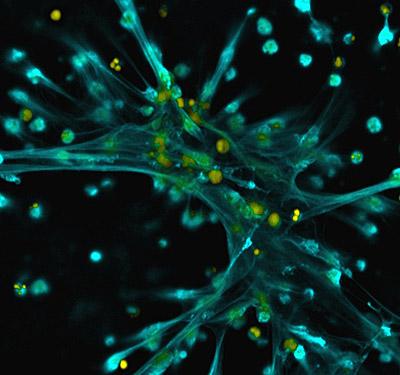Breast cancer drug beats superbug

Neutrophils produce bacteria-ensnaring NETs (shown in blue/green) in response to Tamoxifen treatment. Credit: UC San Diego School of Medicine
Researchers at University of California, San Diego School of Medicine and Skaggs School of Pharmacy and Pharmaceutical Sciences have found that the breast cancer drug tamoxifen gives white blood cells a boost, better enabling them to respond to, ensnare and kill bacteria in laboratory experiments. Tamoxifen treatment in mice also enhances clearance of the antibiotic-resistant bacterial pathogen MRSA and reduces mortality.
The study is published October 13 by Nature Communications.
“The threat of multidrug-resistant bacterial pathogens is growing, yet the pipeline of new antibiotics is drying up. We need to open the medicine cabinet and take a closer look at the potential infection-fighting properties of other drugs that we already know are safe for patients,” said senior author Victor Nizet, MD, professor of pediatrics and pharmacy. “Through this approach, we discovered that tamoxifen has pharmacological properties that could aid the immune system in cases where a patient is immunocompromised or where traditional antibiotics have otherwise failed.”
Tamoxifen targets the estrogen receptor, making it particularly effective against breast cancers that display the molecule abundantly. But some evidence suggests that tamoxifen has other cellular effects that contribute to its effectiveness, too. For example, tamoxifen influences the way cells produce fatty molecules, known as sphingolipids, independent of the estrogen receptor. Sphingolipids, and especially one in particular, ceramide, play a role in regulating the activities of white blood cells known as neutrophils.
“Tamoxifen's effect on ceramides led us to wonder if, when it is administered in patients, the drug would also affect neutrophil behavior,” said first author Ross Corriden, PhD, project scientist in the UC San Diego School of Medicine Department of Pharmacology.
To test their theory, the researchers incubated human neutrophils with tamoxifen. Compared to untreated neutrophils, they found that tamoxifen-treated neutrophils were better at moving toward and phagocytosing, or engulfing, bacteria. Tamoxifen-treated neutrophils also produced approximately three-fold more neutrophil extracellular traps (NETs), a mesh of DNA, antimicrobial peptides, enzymes and other proteins that neutrophils spew out to ensnare and kill pathogens. Treating neutrophils with other molecules that target the estrogen receptor had no effect, suggesting that tamoxifen enhances NET production in a way unrelated to the estrogen receptor. Further studies linked the tamoxifen effect to its ability to influence neutrophil ceramide levels.
The team also tested Tamoxifen's immune-boosting effect in a mouse model. One hour after treatment with tamoxifen or a control, the researchers infected mice with MRSA (methicillin-resistant Staphylococcus aureus), a “superbug” of great concern to human health. They treated the mice again with tamoxifen or the control one and eight hours after infection and monitored them for five days.
Tamoxifen significantly protected mice — none of the control mice survived longer than one day after infection, while about 35 percent of the tamoxifen-treated mice survived five days. Approximately five times fewer MRSA were collected from the peritoneal fluid of the tamoxifen-treated mice, as compared to control mice.
There are two caveats, the researchers said. First, while tamoxifen was effective against MRSA in this study, the outcome may vary with other pathogens. That's because several bacterial species have evolved methods for evading NET capture. Second, in the absence of infection, too many NETs could be harmful. Some studies have linked excessive NET production to inflammatory disease, such as vasculitis and bronchial asthma.
“While known for its efficacy against breast cancer cells, many other cell types are also exposed to tamoxifen. The 'off-target effects' we identified in this study could have critical clinical implications given the large number of patients who take tamoxifen, often every day for years,” Nizet said.
Tamoxifen is taken daily by hundreds of thousands of patients worldwide for the treatment of estrogen receptor-positive breast cancer. The World Health Organization considers tamoxifen an “essential medicine,” due to its cost-effectiveness and safety profile. According to the breast cancer organization Susan G. Komen, generic tamoxifen cost patients about $100 per month in 2010.
Tamoxifen is not the only drug prescribed for other indications that just happen to also boost neutrophil activity. In 2010, Nizet and team reported that cholesterol-lowering statins also enhance NET formation. That study can be found at http://www.
###
Co-authors of this study include Andrew Hollands, Joshua Olson, Jaclyn Derieux, Justine Lopez, John T. Chang, David J. Gonzalez, all of UC San Diego.
This research was funded, in part, by the National Institutes of Health (grants HD071600, AI057153, AI052453 and OD008469).
Media Contact
All latest news from the category: Health and Medicine
This subject area encompasses research and studies in the field of human medicine.
Among the wide-ranging list of topics covered here are anesthesiology, anatomy, surgery, human genetics, hygiene and environmental medicine, internal medicine, neurology, pharmacology, physiology, urology and dental medicine.
Newest articles

Decoding Cancer: 40 Years of Breakthroughs in Genetic Research
Cancer in children and adolescents is rare. Nevertheless, malignant diseases are still one of the most common causes of death in this age group. Survivors of childhood or adolescent cancer…

Let’s Think Before the First Drink: How Early Substance Use Might Lead to Brain Structure Differences Among Adolescents
Many differences appeared to exist prior to any substance use, pointing to the role brain structure may play in substance use risk, NIH-supported study suggests. Studies reveal factors that expose…

Combating Kidney Cancer Using Enhanced Immunotherapies
Medical University of South Carolina Hollings Cancer Center researcher receives Department of Defense Early Career Scholar Award to improve immune therapies by targeting resistant kidney tumors. A Medical University of…



